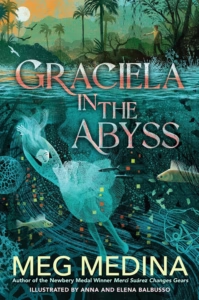Graciela in the Abyss
Meg Medina
Candlewick Press
Published July 1, 2025
Amazon | Bookshop | Goodreads
About Graciela in the Abyss
“A thrilling, action-packed journey filled with heart, bravery, and ghostly exploits.”—Kirkus Reviews (starred review)
A sea ghost, a mortal boy, and a dangerous enchanted harpoon . . . A Newbery Medalist takes us far beneath the waves in this extraordinary foray into fantasy.
In the deepest recesses of the ocean, Graciela—once an ordinary girl—now makes sea glass and assists her friend, Amina, as she welcomes newly awakened sea ghosts from their death sleep. Though Graciela’s spirit is young, she has lived at the bottom of the ocean for more than a hundred years. Meanwhile, in the mortal world on land, twelve-year-old Jorge Leon works in his family’s forge. He’s heard of the supernatural spirits living beneath the ocean’s waves—tales that do nothing to quell his fear of the water. But when Jorge discovers a hand-wrought harpoon with the power to spear a sea ghost, he knows he must destroy it any way he can.
When the harpoon is accidentally reunited with its vengeful creator, unlikely allies Graciela and Jorge have no choice but to work together to keep evil spirits from wreaking havoc on both the living and the dead. If only the answer to saving what they care about didn’t lie within the depths of the abyss . . . Newbery Medal winner Meg Medina and illustrators Anna and Elena Balbusso have crafted a thoughtful tale infused with magic and high-stakes adventure that will leave readers wondering what power lies in the depths of the ocean—and inside each of us.
My Review
That this book received a starred review from Kirkus is no surprise to me. The story world is so imaginative and immersing. The characters feel so real.
I will say the opening is a little bit jarring, only because it’s unusual to open a story with the main character’s death, and especially a death by such a tragic accident. (Graciela falls off a cliff into the sea.) But it does offer a lot of insight into who Graciela is, so that as she awakens as a spirit, we’re unsurprised by some of her choices.
She really grows as a character, and it feels very organic. I love the contrast of her character in the opening scene versus in the final scene. What a transformation.
I have to talk about Jorge, too. He has such a joyless life, and yet, he still finds ways to create joy for himself. He’s kind to others, too. I love the way the story works out for him, though there were moments that I could not see how there would be any happiness at the end for him. That final scene really got me. So perfect.
This story has such a unique setup. Usually, the living human is the main character and the ghost is more of a side character. While both Jorge and Graciela tell the story in their points of view, it feels a little more weighted toward Graciela’s perspective to me. So much of the story is set in the spirit world with Graciela and her community. I love the fantasy landscape that Medina created beneath the ocean’s surface.
The back of the book has a glossary of terms related to the spirit world and the book has a map as well.
If you’re looking for something dark and unusual for your middle grade reader, check this one out.
Content Notes
Recommended for Ages 8 to 12.
Profanity/Crude Language Content
None.
Romance/Sexual Content
None.
Spiritual Content
When someone dies in the ocean or at sea, they sleep for 100 years and then wake as a spirit, where they’re tasked with certain roles to protect the ocean or other spirits. The Almas are guardians who watch over the ocean and all the spirits.
Violent Content
Situations of peril. Description of a girl’s accidental death falling from a cliff into the sea. Descriptions of a ship’s crew lost at sea. Some characters use a harpoon to hunt spirits, intending to kill them and steal their pearl teeth. Jorge’s parents are cruel, threatening him with violence (burning out his tongue, for instance) if he doesn’t do what they expect.
Drug Content
None.
Note: This post contains affiliate links, which do not cost you anything to use but help support this blog. I received a free copy of this book in exchange for my honest review. All opinions are my own.
Marvelous Middle-Grade Monday
I’m sharing this post as a part of a weekly round-up of middle-grade posts called Marvelous Middle-Grade Monday. Check out other blogs with posts about middle-grade books today on Marvelous Middle-Grade Mondays at Always in the Middle.
